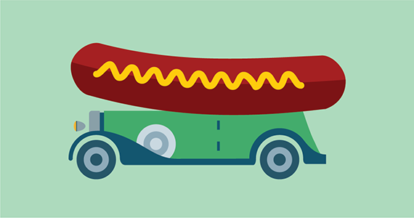Once upon a time – in 1866, actually – there was a rancher named Charles Goodnight. The Internet calls him, “the father of the Texas Panhandle.” It’s been claimed that he’s the best-known rancher in Texas. He was a colorful character. It was once common knowledge that he smoked over 50 cigars a day and at 91 years young, he married his 26-year-old nurse. While all this is true, there is one particular legacy he left behind that has influenced the hospitality industry today: he invented the original food truck, the chuck wagon.
How did the chuck wagon have a lasting impact on our 21st century culinary and business choices, you ask? Good question. The chuck wagon was essentially a portable kitchen. Goodnight crafted it for his first cattle drive, a months long trip where he wasn’t able to use rail, the common transportation at the time. Thus, Goodnight modified an old army surplus wagon. He thought of almost everything. He equipped the wagon with shelves, storage space, a hinged lid for counter space, a water barrel and even a canvas to haul firewood. The food he brought along was either preserved – think dried beans, salted meat, corn meal… yum – or gathered as he went along.

Need to get the word out about your food truck?
The Food Truck’s Industrial Revolution
As food truck culture sprouted, the food stand emerged. In 1872, the first food stand was set up by a man named Walter Scott, who decided to capitalize on hardworking, hurried journalists. He cut windows into a covered wagon and parked it in front of a local newspaper office in Providence, R.I. He sold pie and coffee.
Then in 1894, according to mobile-cuisine.com, sausage vendors emerged along the campuses of Ivy League Universities. Finally, sealing the roadside grub trend, in 1936, Oscar Mayer rolled out the first portable hot dog cart, The Weiner Mobile. And yes, you guessed it; the Weiner Mobile looks exactly like you think it would look like. (For those with insatiable curiosity, you can see the entire fleet of Weiner mobiles through the ages at this link. It’s fascinating… really.)
In the wake of WW2 and the baby boom, the 1950s saw the advent of the ice cream truck. Then food carts began showing up outside of US Army Bases and construction sites. Chip trucks came to be in the late 50s/early 60s. Taco trucks emerged with an increase of immigrants from Mexico, becoming popularized in the 1970s.
Often, referred to as “Roach Coaches” – not the most appetizing name – the food truck wasn’t the affordable, hot off the grill, gourmet samplings that we know and love today. It was basic, blue collar, grab and go greasy fare.
The Food Truck’s Enlightenment
When we think of today’s food trucks, our brains automatically go to fish tacos, decadent pulled pork sandwiches, momma-cooked Mediterranean food, daring combinations of fries, cheese and gravy. While things have changed some since the food truck’s founding years, some things have stayed the same. Instead of dried beans, there are chickpea tikka masala burritos. Instead of salted meat, there’s wild boar on a bun. That said, the food truck has gone from being a blue collar, workman’s meal, to a trendy treat that caters to everyone from young professionals on a budget to Wall Street brokers looking for a quick bite.
So what was the truck that changed the game? Fast forward to 2008. The food truck’s tipping point starts like this:
“Thanksgiving of 2008, Kogi BBQ had first rolled out as the little Korean-taco-truck-that-could, peddling $2 Korean barbecue tacos on the streets of L.A.”
Their website doesn’t lie: they did “set off a flavor bomb.” Kogi BBQ didn’t have a fixed location, so they used social media to announce where they were going to appear. Their offering was adventurous, different, beyond the greasy, tasteless burger offering of other fast food options. Suddenly there was a new way to enjoy a delicious, albeit quick, lunch. Consumers began seeking out food trucks, checking their schedules, planning their lunches around when the food truck would be in the area.
The Food Truck’s Technological Revolution
Shortly after the smartphone, street food apps were born, like NYC Food Truck, Toronto Food Trucks and Roaming Hunger. Blogs were dedicated to food truck tracking. TV shows, like Food Truck Faceoff, were developed and entire festivals were organized to allow consumers to indulge in all their food truck fantasies.
Technology has also been embraced by food truck owners, to help them manage their business – right from the moment they secure their food truck license. From iPad POS technology, to mobile payments, and loyalty programs, technology is now central to the modern day food trucker’s success.
From humble beginnings to a culinary revolution, it might be time to stop calling food trucks a trend. They’ve permeated Western culture in various ways for well over a century. With such a robust history, it makes you wonder what could possibly be next. While we can’t foresee exactly what the next food truck evolution will be, we can’t wait to find out.

Need to get the word out about your food truck?
Free job application template for restaurants
Sign up for our free weekly TouchBistro Newsletter







